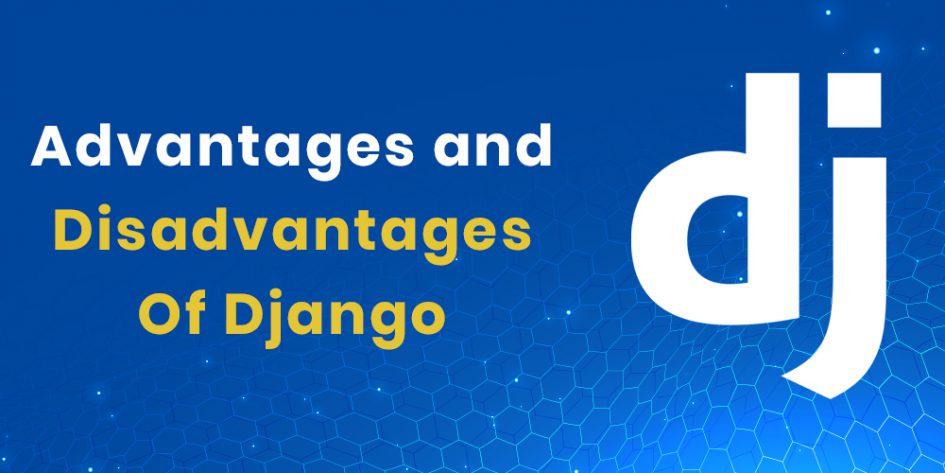When it comes to building and maintaining a great web application, web developers are always on the lookout for reliable frameworks. Fortunately, the search can come to an end with Django. This open-source web framework offers an easy and efficient way to create websites with minimal hassles.
Django is an excellent tool for developing intelligent applications without incurring any development costs. It can serve as a valuable resource for any client’s needs.
To help you make a more informed decision, we’ve compiled a list of some of the most notable advantages and disadvantages of Django:
Django is an open-source web framework that allows developers to create and maintain websites with minimal hassle. It has many benefits that make it an attractive option for building web applications.
Advantages of Using Django
Batteries Included Approach :
Django follows a “batteries-included” approach, which means that developers do not have to write their own codes for certain functionalities. Instead, they can import packages made by community members that are available as open-source.
The Model-View-Template :
Django facilitates rapid development. The Model-View-Template (MVT) architecture allows developers to work on different components in parallel and then integrate them easily. The Don’t Repeat Yourself (DRY) philosophy enables developers to reuse code they have written for prior projects, saving time.
Easy Syntax Structure :
Django is a Python web framework that provides ease of use for creating applications. Python’s easy syntax structure and abundance of in-built libraries and packages help users to get everything they need in one place.
Security :
Security is a crucial aspect of building high-end web applications, and Django provides its best defender to save developers’ efforts. It builds a strong wall for the application’s safety using clickjacking, cross-site scripting, and SQL injections. User authentication is also an important feature that Django provides to safely manage user accounts and passwords.
Community Support System :
Django has a strong community support system. Thousands of developers are working together to fix any errors and bugs that appear, making it continuously improving and evolving. Django has been ruling the IT markets for the past 13 years, making it a very successful web framework out there.
Speed :
When it comes to web applications, speed is a crucial factor that cannot be overlooked. Django is a powerful tool that enables users to swiftly create dynamic web applications, greatly simplifying the deployment process while also reducing costs.
User-Friendly Admin Interface :
Django provides an admin interface for non-technical users to make changes to their websites. This login-protected admin area allows Django developers to alter codes easily.
Complete package :
Developers may never face the issue of unwanted or poorly written codes while using Django. It comes as a complete package with no need to download any packages or libraries from third parties.
Object-oriented programming :
Django provides the functionality of Object-oriented programming, which handles security concerns easily. The use of class, methods, objects, and functionality of overriding makes things easier.
REST framework For API :
The Django REST framework makes it easy to build APIs for web applications. Django users admire the REST framework as it provides powerful API functionality.
Keep It Short And Simple :
Django is both DRY and KISS compliant. The “Don’t repeat yourself” philosophy allows users to reuse the same set of codes in their next project, while “keep it short and simple” represents the features of Django’s simple and easy-to-understand codes.
Versatile Nature :
Finally, Django’s versatile nature allows it to fit easily into different domains. It has been a great help for various popular websites for many years, including OTT platforms and shopping sites.
Limitations of using Django
Not Ideal for Small-Scale Projects :
If you’re planning to develop a small project, Django may not be the best option. This framework is optimized for building large-scale applications quickly, which means it requires a lot of server processing time and bandwidth during development. Since small projects do not require large bandwidth, using Django for such projects may result in wasted resources. Moreover, developers may get overwhelmed by the many advanced features of Django that are unnecessary for small projects.
Limited Multiprocessor Support :
Django does not provide robust support for multiprocessing, which can limit the performance of your application. Other frameworks, such as Java, are more flexible and provide better support for handling multiple requests simultaneously. This can lead to constraints in writing code and require developers to look for alternative solutions.
ORM System Lacks Some Features :
Django’s Object-Relational Mapper (ORM) simplifies database access, but it may not offer all the features that you need. The framework does not provide complete integration with SQL Alchemy, a popular Python toolkit used for database access. This can create limitations in the functionality of your application.
Steep Learning Curve :
Although Django is a relatively simple web framework, it can be difficult to learn. Developers who have prior knowledge of Python may have an easier time grasping the concepts, but those who are new to programming or coming from a different language may struggle at first. However, once you become familiar with Django, it becomes easier to work with.
Monolithic Framework :
Django’s approach is to provide a complete package with its own libraries and tools, rather than relying on external Python packages. This means that developers may not get exposed to a wider range of Python packages and tools. On the other hand, Django comes with many pre-built models that can be reused in different projects, making it easier to work with. Developers do not need to make any changes to these models to use them.
Tight Coupling :
Django’s ORM, template engine system and settings object are all tightly coupled, making it difficult to use different parts of the framework separately. Moreover, all of these packages need to be installed together, which can be a time-consuming and frustrating process.
URL Issues :
Specifying URLs in Django can be challenging and may result in template errors that take time to resolve. This can be a minor issue, but it can be frustrating for developers who are new to the framework.
Conclusion :
When it comes to Django, there are both advantages and disadvantages to consider. While Django has many advantages, its disadvantages cannot be ignored.
For instance, Django is not suitable for small projects because it requires significant server processing time and bandwidth to develop large applications quickly. Moreover, it lacks support for multiprocessing and some features in the Object Relational Mapper (ORM) system. Additionally, learning Django can be challenging, particularly if you are new to programming or coming from another language.
Despite its disadvantages, Django is an excellent choice for large applications in fields such as scientific computing, e-commerce , and real estate. Its tightly coupled framework enables developers to focus solely on their projects rather than complex programming. However, for smaller projects, there are other frameworks that may be a better fit. Ultimately, when deciding on a framework, it is essential to weigh the advantages and disadvantages and choose the one that aligns with the specific project’s needs.





Leave a Reply